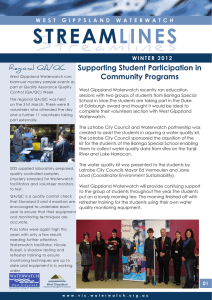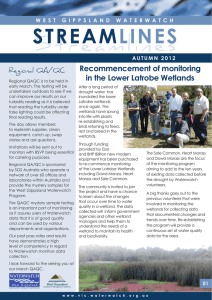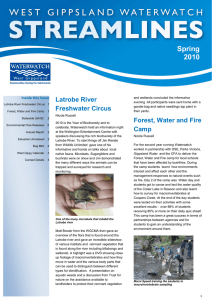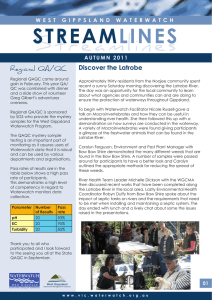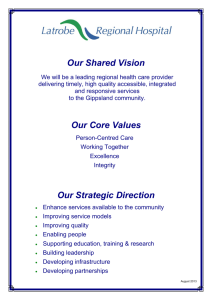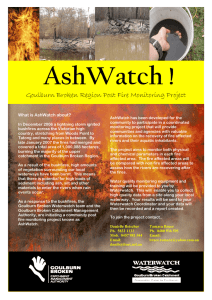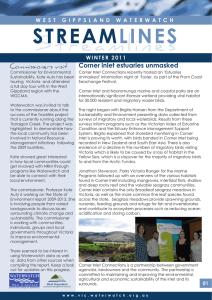Warragul Gumnut Guides Winter 2009
advertisement
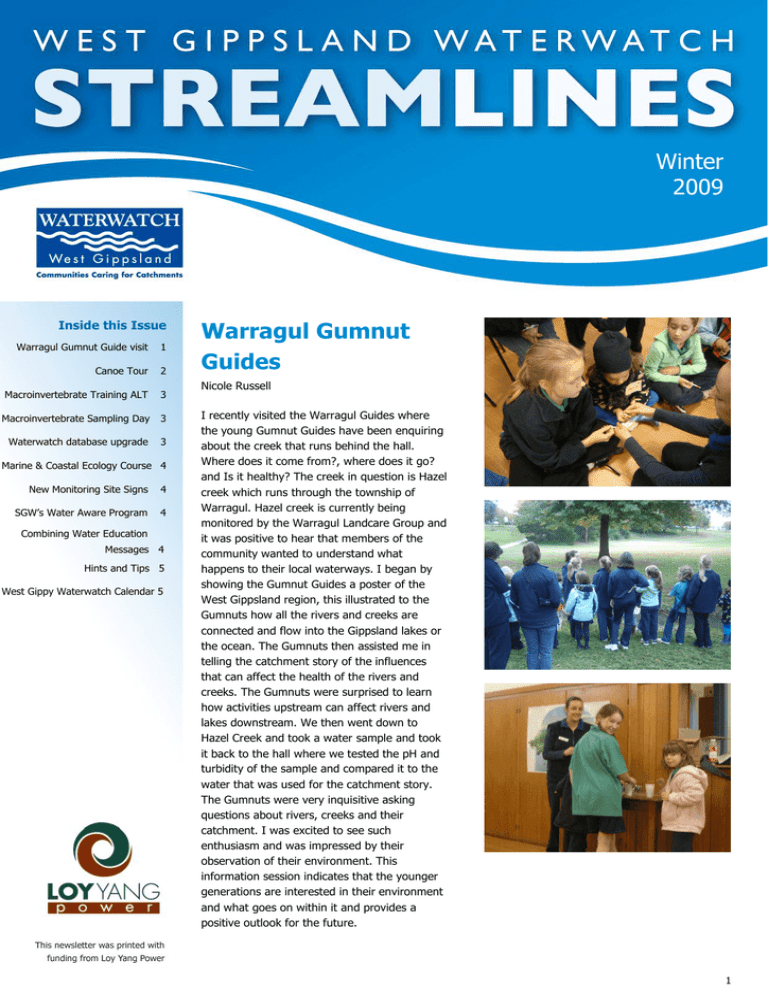
Winter 2009 Inside this Issue Warragul Gumnut Guide visit 1 Canoe Tour 2 Macroinvertebrate Training ALT 3 Macroinvertebrate Sampling Day 3 Waterwatch database upgrade 3 Warragul Gumnut Guides Nicole Russell Marine & Coastal Ecology Course 4 New Monitoring Site Signs 4 SGW’s Water Aware Program 4 Combining Water Education Messages 4 Hints and Tips 5 West Gippy Waterwatch Calendar 5 I recently visited the Warragul Guides where the young Gumnut Guides have been enquiring about the creek that runs behind the hall. Where does it come from?, where does it go? and Is it healthy? The creek in question is Hazel creek which runs through the township of Warragul. Hazel creek is currently being monitored by the Warragul Landcare Group and it was positive to hear that members of the community wanted to understand what happens to their local waterways. I began by showing the Gumnut Guides a poster of the West Gippsland region, this illustrated to the Gumnuts how all the rivers and creeks are connected and flow into the Gippsland lakes or the ocean. The Gumnuts then assisted me in telling the catchment story of the influences that can affect the health of the rivers and creeks. The Gumnuts were surprised to learn how activities upstream can affect rivers and lakes downstream. We then went down to Hazel Creek and took a water sample and took it back to the hall where we tested the pH and turbidity of the sample and compared it to the water that was used for the catchment story. The Gumnuts were very inquisitive asking questions about rivers, creeks and their catchment. I was excited to see such enthusiasm and was impressed by their observation of their environment. This information session indicates that the younger generations are interested in their environment and what goes on within it and provides a positive outlook for the future. 1 Canoe Tour Nicole Russell On April 18th a canoe tour was conducted to connect landholders along the Lower Thomson with a new river health project being undertaken by the WGCMA. Through the Thomson River Offsets Project the WGCMA is hoping to work with landholders to protect wetlands and remnant vegetation on the river frontage and flooplain.. The day was a success with twelve young farmers and landholders jopining in to hear about the ecology of the river and some of work being undertaken to protect it into the future. A similar canoe tour is being planned for the LaTrobe in the near future. These types of events are important way for Waterwatch to help promote the importance of river health and helps to ensure the Waterwatch program remains an integral part of catchment management. Macroinvertebrate Training ALT Nicole Russell I attended a Macroinvertebrate training workshop which included a workshop on how to make ‘water bug’ identification easier in the field. The approach was to trial the method with waterwatch facilitators in order to come to an agreement on a Agreed Level Taxonomy (ALT) that facilitators could use in the field which will be passed on to volunteer monitors. The ALT will include characteristics such as movement and colour that can help id macroinvertebrates to family and sometimes species levels. A draft will be made of the ALT in a booklet form which will then be workshopped again before a final booklet is made. It was a great way to learn to id ‘water bugs’ in the field. This way of identifying is to make things a little easier for Waterwatchers to ID macros in the field instead of having to have access to microscopes, but still providing useful data on biological indicators on the health of rivers and creeks. Macroinvertebrate Sampling Day Nicole Russell On Saturday May 9th Waterwatch volunteers went down to Martin Walker Reserve to learn how to sample for macroinvertebrates. They were shown the two different techniques for sampling: Kick and sweep sampling. The samples were then taken back to white trays where we looked for macroinvertebrates. A few different families were found including water boatmen (Family: Corixidae), Caddiesflies (Family: Leptoceridae), Freshwater Shrimps (Family: Atyidae) and Backswimmers (Family: Notonectidae). It was very exciting for everyone to find macroinvetebrates in their samples which led to everyone showing a keen interest in learning more about how to identify macroinvertebrates. 2 Volunteer Interest Session Waterwatch Database upgrade Nicole Russell Tanya Cowell On Wednesday the 13th May a snake/reptile interest session was held for Waterwatch volunteers at the Heyfield Wetlands centre. Raymond Hoser of Snakebusters brought along his snakes, crocodiles, pythons and lizards to show and explain about the different types of snakes and reptiles found in Australia. Participants were able to see Brown , Black, Tiger and Copperhead snakes as well as being able to handle lizards and pythons. A King Brown snake was also on show with striking jaffa colours of a dark orange underbelly that melded with a black top. It was beautiful! Raymond gave us two pieces of advice when confronted with a snake in the field: 1. If you see a snake walk away from it, generally they move as fast as people and 2. If a snake is near your feet freeze, snakes generally only strike at moving objects. He also advised that if you see a snake in the bush never pick up the snake. They only bite people out in the bush through fear and when a large person bends down to pick you up it can appear threatening. Waterwatch Victoria are working on the development of a web based database. While any metion of the word “database” usually casues my eyes to glaze over, I’m very excited about this project! The new database is to be housed on the WWVic website. Waterwatch volunteers will have their own profile, be able to input data and update other site observations and personal information. Please note that Watrwatch Failitators will still input data for those volunteers who choose not to enter their data through the website. Importantly, all data and personal information will be protected from hackers. The database will also offer links to additional notes on parameters and equipment instructions. General reference documents will also be hyperlinked for volunteers. Data entry sections will include habitat, phys/chem. and macros, plus the site diary. Frogs and birds may be included as a monitoring log too. Equipment servicing, monitor training, QAQC records and the like will be shown on individual volunteer pages. Another exciting feature of the databse is that volunteers and the general public will be able to extract data and graphs. This is a feature that many of you have inquired about in the past. This is another opportunity to distribute data to a wider audience. The database development phase will finish in July, with a trial roll out and implementation to happen soon after. We will keep you updated. Raymond showing everyone his snakes Tiger snakes generally have no markings on their face Copperhead snake have whitish etchings on face. Can be confused with Red bellied snakes Victorian Brown snake on top NSW species on bottom Peter Repschlager holding some very heavy but well behaved pythons All snake photos supplied by Raymond Hoser 3 Marine and Coastal Ecology Course Tanya Cowell A Waterwatch Coastal Ecology Course is to be held on Sunday the 21st of June in Inverloch. The course has been partly funded by grants from the Victorian Volunteer small grants program and CoastAction/CoastCare. The one day workshop will include a range of highly regarded guest speakers. John Sherwood from Deakin University will present on the chemistry and dynamics of estuaries. Rosemary Swart of South Gippsland Environmental Education and Interpretation will cover the geology of South Gippsland and Bruce Atkin of Coast Action/CoastCare will speak about the coastal and marine environment. There will also be a rockpooling session to conclude the day. This workshop is specifically themed towards “catchment to sea”, with particular focus on the chemistry and water quality aspects to allow Waterwatch volunteers a dfferent insight into their monitoring. Please see the attached flyer. If you would like to attend this event please tear off the response slip and post back to: Waterwatch PO Box 1374 Traralgon 3844 by the 12th of June. New Monitoring Site signs Tanya Cowell You may have noticed some additional monitoring site signs appear in your area – or even at your site. These signs were sponsored by TruEnergy and have been placed in prominant Waterwatch site locations. Due to a change in road signage regulations these signs are now required to be parallel with the road – to avoid distracting drivers. Feedback we have received indicates that the presence of these signs informs peple of both the Waterwatch program and the volunteer collected data that exists for the site. One of the new signs installed near Foster South Gippsland Water's Water Aware Program Ros Griggs The Water Aware Program is a partnership between South Gippsland Water, Smart Water Fund, Waterwatch, West Gippsland Catchment Management Authority, South Gippsland Shire, Southern Rural Water, Bee Wise Education The program has successfully run for the past two years in the Korumburra area under the banner “Water Warriors”. Now re-branded “Water Aware” The Smart Water Fund grant will make the program available to the 35 Primary and Secondary Schools across the South Gippsland Region over the next three years. Water Aware is an ambassadorial program for years five to eight, where selected students attend a two day workshop gaining the whole water picture, within their community. Learning areas include water collection, water quality, water use (rural, commercial and urban), the treatment of waste water and the effects of effluent on the environment. Knowledge is gained through exposure to guest speakers and tours of the area and local water infrastructure. Students then research a topic and with the help of facilitators deliver a presentation to their school communities as well as the general community and community leaders at a gala presentation evening. Activities are designed using Victorian Essential Learning Standards curriculum and promote leadership skills, planning and information technology, working in teams, community engagement and building on relationships with community organisations. Combining Water Education Messages Marni Speed The Water Aware program is one way in which Waterwatch is working together with other agencies to offer learning opportunities to schools in West Gippsland (see previous article by Ros Griggs). We have also recently worked alongside Gippsland Water to deliver 4 Professional Development for Primary teachers on incorporating water education into their curriculum. Hints and Tips Teachers started off in March by attending a hands-on Professional Development day in Maffra where they gained valuable information, skills and resources, VELS appropriate, for use back in the classroom. Next term will see these Waterwatchtrained teachers taking their students out of the classroom to investigate the inhabitants and health of their local waterways. Water quality testing and stream sampling for bug life will take place close to schools giving the students practical experiences out in the environment to engender ownership of and care for their local area. Next up Waterwatch will be working with the Department of Sustainability and Environment and CFA to deliver a three day Forest Education school camp in Rawson, culminating on World Environment Day on June 5th. The “Water” Day will include canoeing, water quality testing and macroinvertebrate sampling at Coopers Creek. Hopefully it won’t be too cold! Look out for a report in the next edition of Streamlines. Just a reminder that when reading reactive phosphorus results from the slide card, please round down if you are stuck between two options. This is the standard practice, as you can guarantee the lower value, but not the higher one. The use of less than signs in this case is not recommended. Instead, just a note to mention that you thought the RP was actually slightly higher than the value but it was rounded down. West Gippy Waterwatch Calendar Sunday 12th June – Coastal Ecology Course for Waterwatch Volunteers, Inverloch. Wednesday 10th June – Latrobe River Canoe Tour, limited spaces please ring Nicole Russell on 1300 094 262 to confirm participation 5 Gippsland Waterwatch Contacts Nicole Russell West Gippsland Facilitator PO Box 1374, Traralgon 3844 Phone: 1300 094 262 Email: nicoler@wgcma.vic.gov.au Tanya Cowell South Gippsland Facilitator PO Box 1374, Traralgon 3844 Phone: 1300 094 262 Email: tanyac@wgcma.vic.gov.au Michelle Dickson River Health Team Leader PO Box 1374, Traralgon 3844 Phone: 1300 094 262 Email: michelled@wgcma.vic.gov.au Marni Speed Facilitator PO Box 1374, Traralgon 3844 Phone: 1300 094 262 Email: marnis@wgcma.vic.gov.au Key Stakeholders and Sponsors 6
